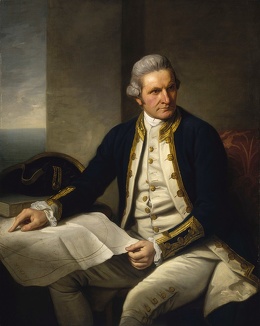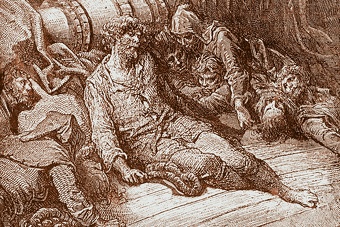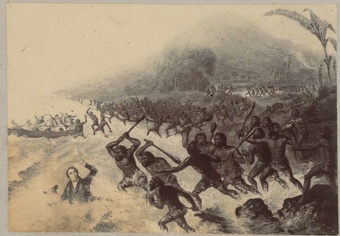Home | Category: History / History and Religion / History and Exploration
CAPTAIN JAMES COOK
Captain James Cook (1728 –1779) was a British explorer, cartographer and naval officer famous for his three voyages between 1768 and 1779 in the Pacific Ocean. He claimed possession of Australia and New Zealand and for England, established modern standards in sailing and among other things introduced tattooing ro the West before he killed by local people in Hawaii. There is an arrow in a museum storeroom in Sydney reportedly made from Cook’s shinbone.
Cook was a British Royal Navy officer and displayed great talent in leading men. His voyages "elevated exploration to a science" He made detailed maps, explored much new territory and developed a cure for scurvy, the scourge of transoceanic voyages. He achieved the first recorded European contact with the eastern coastline of Australia and the Hawaiian Islands, and did the first recorded circumnavigation of New Zealand.
Cook is sometimes refereed to as the "world's greatest negative explorer." By meticulously covering the South Pacific in an organized grid-like pattern he proved within a reasonable doubt that the Great Southern continent did not exist. In the process he almost discovered Antarctica by passing within 70 miles of the continent's coast. Icebergs prevented him from venturing closer.≈
Cook joined the British merchant navy as a teenager and joined the Royal Navy in 1755. He saw action in the Seven Years' War and subsequently surveyed and mapped much of the entrance to the St. Lawrence River during the siege of Quebec, which brought him to the attention of the Admiralty and the Royal Society. This acclaim came at a crucial moment for the direction of British overseas exploration, and it led to his commission in 1768 as commander of HMS Endeavour for the first of three Pacific voyages. [Source: Wikipedia]
Books: “Cook: The Extraordinary Voyages of Captain Cook” by Nicholas Thomas, 2003; “Blue Latitudes” by Tony Horwitz, Henry Holt, 2002]
Related Articles:
VOYAGES OF CAPTAIN JAMES COOK: SHIPS, CREW, MISSIONS, DISCOVERIES ioa.factsanddetails.com ;
CAPTAIN JAMES COOK IN NEW ZEALAND AND AUSTRALIA ioa.factsanddetails.com
CAPTAIN JAMES COOK IN THE PACIFIC: DESCRIPTIONS, EVENTS AND PLACES VISITED ioa.factsanddetails.com ;
DISCOVERY OF AUSTRALIA BY EUROPEANS ioa.factsanddetails.com
FIRST EUROPEANS IN NEW ZEALAND: EXPLORERS, TASMAN, COOK, SEALERS ioa.factsanddetails.com ;
FIRST EUROPEAN SETTLERS IN NEW ZEALAND AND THEIR IMPACT ON THE MAORI ioa.factsanddetails.com
SPICES, TRADE AND THE SPICE ISLANDS factsanddetails.com ;
EUROPEANS DISCOVER THE PACIFIC AND OCEANIA ioa.factsanddetails.com ;
MAGELLAN AND THE FIRST VOYAGE AROUND THE WORLD ioa.factsanddetails.com ;
FIRST EUROPEAN IN NEW ZEALAND: EXPLORERS, SETTLERS AND THEIR IMPACT ON THE MAORI ioa.factsanddetails.com
EUROPEANS IN THE PACIFIC IN THE 1800S: WHALERS, MISSIONARIES, COPRA AND FORCED LABOR ioa.factsanddetails.com ;
Cook's Early Life and Family
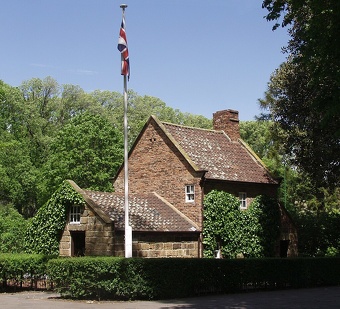
"Captain Cook's Cottage", Fitzroy Gardens, Melbourne; Cook's parents lived there; it is not clear whether he did or not
James Cook was born on November 7, 1728 in the village of Marton in the North Riding of Yorkshire and baptised seven days later in the parish church of St Cuthbert, where his name can still be seen in the church register. He was the second of eight children of James Cook (1693–1779), a migrant farm laborer from Scotland, and his locally born wife, Grace Pace (1702–1765). In 1736, his family moved to Airey Holme farm at Great Ayton, where his father's employer, Thomas Skottowe, paid for him to attend the local school. In 1741, after five years' schooling, he began work for his father, who by that had been promoted to farm manager.
Cook became quite proficient in mathematics, astronomy and charting by the time of his first voyage despite receiving no formal education byond the fifth grade. When he had free time he liked to climb a local hill and seek solitude there, Cooks' Cottage, his parents' last home, which he is likely to have visited, is now in Melbourne, Australia, having been moved from England and reassembled, brick by brick, in 1934.
In 1745, when he was 16, Cook moved 32 kilometers (20 miles) to the fishing village of Staithes, to be apprenticed as a shop boy to a grocer and haberdasher. Historians have speculated that this is where Cook first felt the lure of the sea while gazing out of the shop window. After 18 months, not proving suited for shop work, Cook travelled to the nearby port town of Whitby, where he began his life at sea,
Cook didn't get married until he was 34 and spent half of his married life at sea. In one period he was gone for six out of seven years. He married Elizabeth Batts, the daughter of Samuel Batts, keeper of the Bell Inn in Wapping and one of his mentors, in December 1762. Of the six children he had with his wife Elizabeth three died shortly after they were born and two more didn't reach the age of 18. James lives from 1763 to 1794. Nathaniel (1764–1780 was lost aboard HMS Thunderer which foundered with all hands in a hurricane in the West Indies). Hugh (1776–1793 died of scarlet fever while a student at Christ's College, Cambridge. When not at sea, Cook lived in the East End of London. Cook has no direct descendants – all of his children died before having children of their own.
Cook's Early Life at Sea
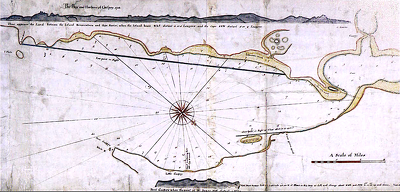
hand-drawn chart of Gaspé Bay, Canada made by Cook in 1758, soon after he learned surveying;a year later it became the first chart of Cook's to be engraved and printed
When was in Whitby he was introduced to John and Henry Walker, prominent local ship-owners in the coal trade. Cook became an apprentice on a coal carrier when he was eighteen. He served in a in small fleet of vessels that carried coal along the English coast. He spent several years doing this and when had time studied geometry, trigonometry, algebra, astronomy and navigation – all skills needed to be captain of a ship. [Source: Wikipedia]
After his three-year apprenticeship with coal ships was finished, Cook began working on trading ships in the Baltic Sea. After passing his examinations in 1752, he quickly worked his up through the merchant navy ranks. In 1755, shortly after being offered command of a merchant vessel, he volunteered for service in the Royal Navy, when Britain preparing to fight what would become the Seven Years' War, mainly between Britain and France. Cook had to at the bottom of the naval ranking, but there were more opportunities and a better chance of long-term career advancement in the military rather than merchant sector. He entered the Navy at Wapping in June 1755.
Cook did to not volunteer for the navy until he was 27, very late for a seaman. His natural aptitude from mathematics and his excellent navigational skills helped him earn the Royal Navy commission to explore the South Pacific. Before his historic trip around the world, Cook went on voyage to what is now Newfoundland and Quebec in 1766.
Cook's first posting was with HMS Eagle, serving as able seaman and master's mate. In 1755, he took part in Eagle's capture of one French warship and the sinking of another, following which he was promoted to boatswain in addition to his other duties. His first temporary command was in March 1756 when he was briefly master of Cruizer, a small cutter attached to Eagle while on patrol. In June 1757 Cook formally passed his master's examinations, qualifying him to navigate and handle a ship of the King's fleet. He then joined the frigate HMS Solebay as master.
During the Seven Years' War, Cook served in North America as master aboard the fourth-rate Navy vessel HMS Pembroke. He took part in the major amphibious assault that captured the Fortress of Louisbourg from the French in 1758, and in the siege of Quebec City in 1759. He displayed his skill at surveying and cartography and was responsible for mapping much of the entrance to the Saint Lawrence River and the jagged coast of Newfoundland. His accurate maps of Newfoundland were the first scientific, large scale, hydrographic surveys to use precise triangulation to establish land outlines. His mastery of practical surveying, often achieved under often tough conditions, attracted the attention of the Admiralty and Royal Society and contributed to their decision to hire Cook to captain his famous voyages. Cook's maps were used into the 20th century.
Cook’s Voyages
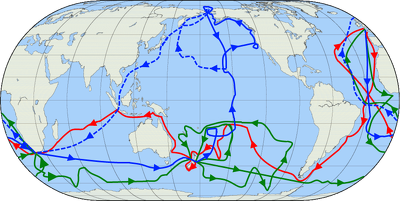
Three voyages of Captain James Cook, with the first in red, second in green, and third in blue; the route of Cook's crew following his death is indicated with dashed blue line
Captain James Cook made three major voyages in the Pacific
First voyage (1768–1771)
Second voyage (1772–1775)
Third voyage (1776–1779)
Cook and his crew recorded in great detail the people of the areas that they visited — their appearance, dress, language, customs, beliefs and activities.
In these voyages, Cook sailed thousands of miles across largely uncharted areas of the globe. He mapped lands from New Zealand to Hawaii in the Pacific Ocean in greater detail and on a scale not previously charted by Western explorers. He surveyed and named features, and recorded islands and coastlines on European maps for the first time. He displayed a combination of seamanship, superior surveying and cartographic skills, physical courage, and an ability to lead men in adverse conditions.
Terence E. Hays wrote in the “Encyclopedia of World Cultures”: “The list of islands and island groups 'discovered" or "rediscovered" by Cook is long, induding the Hawaiian group, Christmas Island, New Caledonia, the Cook Islands, the Gilbert Islands, Fiji, Tonga, the Solomon Islands, Easter Island, and part of the Tuamotu Archipelago. In addition, his carefully drawn charts proved finally that New Guinea, New Zealand, and Australia were not joined together, as many had supposed. Cook's accomplishments, including a vast quantity of scientific specimens and observations, have never been equaled, in the Pacific or elsewhere in the world. By the conclusion of Cook's voyages, the main outlines of the island groups of Oceania were charted, and only locally systematic exploration would be undertaken in the future. From the Europeans' point of view, now was the time for exploitation of the resources and people of this vast new realm. [Source:“Encyclopedia of World Cultures, Volume 2: Oceania,” edited by Terence E. Hays, 1991]
See Separate Article VOYAGES OF CAPTAIN JAMES COOK: SHIPS, CREW, MISSIONS, DISCOVERIES ioa.factsanddetails.com
Captain Cook, Scurvy and the Health of His Crew
Cook was also one of the first captains to insist that his men eat citrus fruit with Vitamin C to stave off scurvy, one of the main causes of death among sailors of that time. Of the 94 officers, scientists, seamen and marines on Cook's first voyage, a third died of dysentery and malaria but no one died of scurvy because Cook was savvy enough to know that certain foods prevented the disease (those with Vitamin C which had to yet been discovered). After his second voyage, Cook was awarded the Copley Gold Medal for completing his second voyage without losing a man to scurvy.
For each expedition Cook procured ample fresh food and fruit for his crew.The main sources of Vitamin C on Cook's voyages were onions and cabbages made into "Sour Krout" which were loaded on “Endeavour” by the barrelful, with enough to supply every man on the ship with two pounds a week. At first the seamen hated soups made with the stuff. To get the men to eat it, Cook used reverse psychology. He severed it only to his officers, who pretended they loved it. Crew men then accused Cook of "favoritism" and soon everybody was eating it.
Cook was also strict about personal hygiene and keen on keeping his boat tidy and clean. He ordered his crew to wash themselves and the boat every day, and every morning the windows were opened to let fresh air into the chambers. With this routine he taught preventive health care to the men under his command. On the second voyage only four men died in the three-year 70,000 mile journey. On Magellan's voyage, in contrast, only 14 men survived out of the original 300 that started the voyage. [Source: Dominik, Naleia Yachting, May 12, 2016]
Captain Cook’s Death and Aftermath
Cook was killed in Hawaii after being clubbed on the head and held under water and drowned by islanders in Hawaii after he got angry with them for stealing the nails that held his ship together. The incident happened in 1779, during Cook's third voyage in the Pacific, after tensions escalated between his men and the local people of Hawaii and Cook himself to attempted kidnap chief Kalaniʻōpuʻu, the King of Hawaii, on the shoreline of Kealakekua Bay, in Hawaii.
After a month's stay in Hawaii, Cook attempted to resume his exploration of the northern Pacific, but shortly after leaving Hawaii Island Resolution's foremast broke, so the ships returned to Hawaii for repairs. Tensions rose, and quarrels broke out between the Europeans and Hawaiians at Kealakekua Bay, including the theft of wood from a burial ground under Cook's orders. On February 13, 1779, an unknown group of Hawaiians stole one of Cook's longboats. Cook responded to the theft by attempting to kidnap and ransom Kalaniʻōpuʻu.
By then the Hawaiian people had become "insolent", according to Cook, even with threats to fire upon them. On February 14, 1779, Cook went ashore to the King's village and took him by his own hand and led him away. One of Kalaniʻōpuʻu's favorite wives, Kanekapolei, and two chiefs approached the group as they were heading to the boats. They pleaded with the king not to go. An old kahuna (priest), chanting rapidly while holding out a coconut, attempted to distract Cook and his men as a large crowd began to form at the shore. As Cook turned his back to help launch the boats, he was struck on the head by the villagers and then stabbed to death as he fell on his face in the surf.
Cook was first struck on the head with a club by a chief named Kalaimanokahoʻowaha or Kanaʻina (namesake of Charles Kana'ina) and then stabbed by one of the king's attendants, Nuaa. The Hawaiians carried his body away towards the back of the town, still visible to the ship through their spyglass. Four marines, Corporal James Thomas, Private Theophilus Hinks, Private Thomas Fatchett and Private John Allen, were also killed and two others were wounded in the confrontation.
The esteem which the islanders nevertheless held for Cook caused them to retain his body. Following their practice of the time, they prepared his body with funerary rituals usually reserved for the chiefs and highest elders of the society. The body was disembowelled and baked to facilitate removal of the flesh, and the bones were carefully cleaned for preservation as religious icons in a fashion somewhat reminiscent of the treatment of European saints in the Middle Ages. Some of Cook's remains, thus preserved, were eventually returned to his crew for a formal burial at sea.
The site where Cook was killed in Hawaii was marked in 1874 by a white obelisk. This land, although in Hawaii, was deeded to the United Kingdom by Princess Likelike and her husband, Archibald Scott Cleghorn, to the British Consul to Hawaii, James Hay Wodehouse, in 1877. A nearby town is named Captain Cook, Hawaii; several Hawaiian businesses also carry his name.
Clerke assumed leadership of the expedition and made a final attempt to pass through the Bering Strait. He died of tuberculosis in August 1779 and John Gore, a veteran of Cook's first voyage, took command of Resolution and of the expedition. James King replaced Gore in command of Discovery. The expedition returned home, reaching England in October 1780. After their arrival in England, King completed Cook's account of the voyage.
Captain Cook’s Legacy
Whilst there is controversy over Cook's role at the forefront of British colonialism and the violence associated with his contacts with indigenous peoples, he left a legacy of scientific and geographical knowledge that influenced his successors well into the 20th century, and numerous memorials worldwide have been dedicated to him. At a time when Cook statues were being torn down and his role in colonization process was condemned, Robert Tombs defended Cook, arguing "He epitomized the Age of Enlightenment in which he lived," and in conducting his first voyage "was carrying out an enlightened mission, with instructions from the Royal Society to show ‘patience and forbearance’ towards native peoples".
Captain Cook was a highly respected seafarer. His reputation and success was also respected by his enemies. One day a pirate ship attacked and conquered one of his ships. Cook ordered his men not to counterattack. When the commander of the pirates saw that Cook was in charge of the ship, he called off the attack. Even President Benjamin Franklin, although the United States and Great Britain were enemies, issued orders that the US Navy were not to attack Cook’s fleet.
When Captain Cook landed in New Zealand he encountered the native Maori with face tattoos. His crew were so impressed by these tattoos they wanted some for themselves. They copied the Maori tattoo patterns and observed how the practice was done, and introduced the method of body adornment in Europe. This is considered the origin of the custom of sailors getting tattoos.
The television show Star Trek is is said to be based on Cook’s voyages, with Captain James Kirk modeled on captain James Cook himself. The introductory lines of the show: “To boldly go where no man has gone before“ is said to be taken from Cook’s diaries. The Apollo 15 Command Module Endeavour was named after Cook's ship, HMS Endeavour, as was the Space Shuttle Endeavour .In addition, the first Crew Dragon capsule flown by SpaceX was named for Endeavour. Another shuttle, Discovery, was named after Cook's HMS Discovery.
Numerous institutions, landmarks and place names reflect the importance of Cook's contributions, including the Cook Islands, Cook Strait, Cook Inlet and the Cook crater on the Moon. Mount Cook, the highest summit in New Zealand, is named for him. Another Mount Cook is on the border between the U.S. state of Alaska and the Canadian Yukon territory.
Captain Cook’s Contributions to Navigation
Cook’s more accurate navigational charting of large areas of the Pacific was a major achievement. To create accurate maps, latitude and longitude had to accurately measured Measuring latitude and determining direction could be determined by observations of the stars and the sun, but as late as the early 18th century a system of measuring longitude had yet to be devised. The chronometer, the devise that determines longitude, was not used until 1765 and Cook was one of the first to put it to use. .
During the Age of Discovery, sailors determined longitude by making careful observations of the moon with delicate instruments and complicated conversion tables. The measurements had to be precise. An error of 5' in observations translated to an error of 2½ degrees in longitude (about 150 miles). An inaccurate measure could beach a ship on sand bar or tear its hull open on a dangerous reef.
The problem on longitude was finally solved by an uneducated clockmaker named John Harrison who figured out that all that was needed was an accurate clock. Sir Kenelm Digby had observed earlier that for every 15 degree sailed west there was a one hour difference in time. Harrison surmised if one had an accurate clock that kept time in England (Greenwich Mean Time) longitude could be figured out by determining the time difference between the ship and Greenwich mean time.
After 46 years of work in his workshop, Harrison finally developed a waterproof, motion-proof clock that was accurate enough to keep Greenwich time over several months (clocks in his time often lost several minutes a day).
The Earth turns a full 360 degrees relative to the sun each day. Thus longitude corresponds to time: 15 degrees every hour, or 1 degree every 4 minutes. Cook gathered accurate longitude measurements during his first voyage from his navigational skills, with the help of astronomer Charles Green, and by using the newly published Nautical Almanac tables, via the lunar distance method – measuring the angular distance from the moon to either the sun during daytime or one of eight bright stars during night-time to determine the time at the Royal Observatory, Greenwich, and comparing that to his local time determined via the altitude of the sun, moon, or stars.
On his second voyage, Cook used the K1 chronometer made by Larcum Kendall, which was the shape of a large pocket watch, 5 inches (13 cm) in diameter. It was a copy of the H4 clock made by Harrison, which proved to be the first to keep accurate time at sea when used on the ship Deptford's journey to Jamaica in 1761–62.
Image Sources: Wikipedia Commons
Text Sources: Source: National Geographic article by Alan Villiers; the book "The Discoverers" by Daniel Boorstin, “Encyclopedia of World Cultures, Volume 2: Oceania,” edited by Terence E. Hays, 1991, Wikipedia, New York Times, Washington Post, Los Angeles Times, Times of London, Lonely Planet Guides, Library of Congress, The Guardian, National Geographic, Smithsonian magazine, The New Yorker, Reuters, Associated Press, AFP, BBC, CNN, and various books, websites and other publications.
Last updated October 2025

